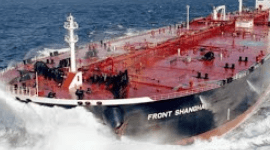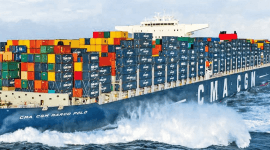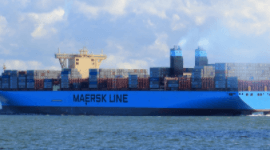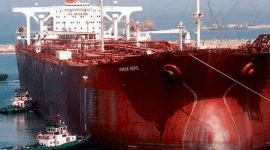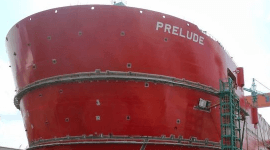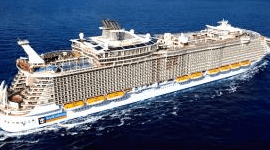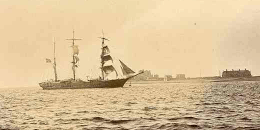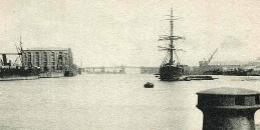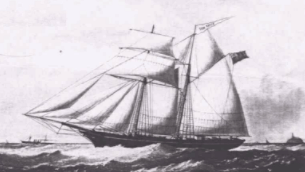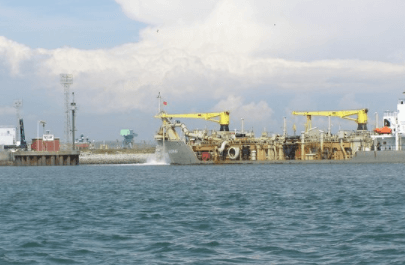The Result at War

By 1890 the schooner fleet of Barrow's Thomas Ashburner was operating primarily from Connah's Quay. One of the most successful vessels was the Useful, under the command of Capt. Robert Wright. He had sailed for the Ashburners as man and boy, having been given command of first the Margaret Ann and then the Useful, from her launch in 1879. He lived at Connah's Quay rather than Barrow, and earned his living largely in the short sea trades between the Dee River ports, the Isle of Man, Ireland and Furness. As his ship reached the end of her insured life, his success encouraged the Ashburners to supply him with a new and larger schooner.
Their own shipyard was by now closed down, and the Ashburners had to look elsewhere for a builder. By this time too, iron and steel schooners were commonly appearing in the fleets of their rivals. Such vessels had greater carrying capacity than their wooden counterparts of similar dimensions, and were also more durable and cheaper to maintain. They had appeared at Barrow first in James Ashcroft's fleet and had begun appearing in the fleet of James Fisher in 1885. By 1890 four metal-hulled schooners had been delivered to Fishers from the Carrickfergus shipyard of Paul Rodgers, with two more on order. Paul Rodgers was commissioned by the Ashburners to build what was to be both his and their last schooner. The design of this vessel was a collaborative effort between Rodgers, Richard Ashburner and her future captain, Robert Wright. The steel schooner was to work in the same trade as the Useful, carrying heavy cargoes into narrow estuaries, and therefore had to have all the requirements of a typical "Barrow flat". However, her designers were concerned with more than just functional details. Since the closure of his shipyard, Richard Ashburner had been largely involved in designing yachts, and Rodgers too was a distinguished yacht-builder. Using the skills gained in this work, they aimed to invest their new schooner with both speed and a graceful appearance. The design evolved at a series of meetings between the three men, and eventually a set of plans was drawn by Richard Ashburner to describe the result of their discussions. And the Result was the name decided for the new ship.
Rodgers probably started construction of the Result early in 1892. However, as work proceeded he was overtaken by financial difficulties and was forced to sell his shipyard to a shipbuilder from Ayr. When the Result was finally completed her builder's name was listed as Robert Kent & Co. They themselves suffered financial misfortune, possibly as a result of the considerable investment they had made in improving the shipyard, and less than two years after the takeover they too were bankrupted. The Result was long gone by this time, having been launched early in January 1893.
The Result had been built to Special Survey and was classed 100 years A1. Her frames and plates were of steel and she measured 122 gross tons. Her dimensions characterised her as a coasting schooner, for she was very shallow-drafted, and she was longer and narrower than the Ashburners' previous three-masted coasters, the M.E. Johnson and James Postlethwaite. The grace of her hull was augmented by a counter stern, and she had clipper bows with a handsome sheer. Her initial rig had more in common with a deepwater vessel than a coaster, for she carried double topsails and a flying topgallant on her foremast. In this her designers had been over-ambitious, and soon after her launch the lower masts were reduced in height by several feet and the topgallant-yard was removed. Surprisingly she had an open wheel, but there was an aft shelter used as paint locker and lavatory. She was initially owned by Thomas Ashburner & Co. and was registered at Barrow.
As the final product of two of the most skillful of all the schooner-builders, it is not surprising that the Result has been described as the finest small sailing vessel ever built in Britain. In part this was due to her looks, but was also a tribute to her speed. In a straw poll conducted amongst schoonermen in the 1940's by Basil Greenhill, the Result was acclaimed as one of the fastest of the later schooners, especially when sailing on the wind. Furthermore, these qualities were not achieved by compromising her cargo-carrying ability, for she was to have a long, varied and successful career which outlasted that of all her contemporaries.
When the Ashburners disposed of their fleet in 1909, the Result was bought for £1100 by Capt. Henry Clarke of Braunton, North Devon. And though Braunton had a large fleet of coastal sailing vessels, this new arrival from the Irish Sea was soon granted the admiration of the local seamen ; in the words of one of her crew, "She was the biggest ship we had in Braunton, and the finest. She was a fast and good sailer". The Result was to spend the rest of her career sailing from Braunton, interrupted only by a spell with the Royal Navy during the First World War, and she outlived all the Ashburners' other schooners.
Capt. Clarke had quickly sold some of his shares to four of his relatives, and also to Capt. Incledon, who became her new master. From her new home in North Devon the steel schooner continued to sail in the Home trade, at first as a sailing ship. Despite her acknowledged sailing speed, in March 1914 her square topsails and yards were removed and she was fitted with a 45 b.h.p. single cylinder Kromhaut engine. The men of Braunton and the neighbouring port of Appledore had been amongst the first to adopt auxiliary engines, and even the Result was vulnerable to the increasing competition from steamships and Dutch-owned motor schooners. The conversion into an auxiliary certainly improved her prospects, for sailing on her engine alone she could still achieve five knots with a full cargo. Soon after this alteration her registration was transferred from Barrow to Barnstaple.
During the First World War the Result was requisitioned by the Royal Navy to act as a Q-ship.
Once back at Braunton the Result was rerigged, losing the square yards that had been temporarily restored to her by the Royal Navy. Over the next fifty years the ship's masts and yards were to be frequently altered as her owners adapted her to whatever trade they could find, balancing the advantages of the sails in fuel economy against the costs of maintenance and extra crew. In 1921 the schooner was operating in the slate trade from Portmadoc to Antwerp and other continental ports, and for this she was re-equipped with a single square topsail. However, this brief post-War boom in trade soon subsided, and in 1924 the square yards were sent down for the penultimate time. Rigged as an auxiliary fore-and-aft schooner, the Result operated in the short sea trade along the South coast. She was still commanded by Capt. Incledon, though she was now owned jointly by Capt. Clarke and another Braunton seaman, Capt. Tom Welch. For several years their ship was regularly employed in trade between Newhaven and Southampton, in friendly rivalry with a Dutch auxiliary schooner, the Jacoba. Shortly before the Second World War her ownership passed in its entirety to Capt. Welch. There was to be no repeat of her previous fighting career, for the Result spent the War in the Bristol Channel trade, carrying coal from South Wales ports.
In 1946 the schooner was completely refitted, the first engine being replaced by a more powerful one of 120 h.p. Even so, she retained her full sail plan and was the last coasting schooner to keep her gaff topsails. Her new commander was the owner's son, Capt. Peter Welch, and under him the Result was nearly lost. She had arrived at Cardiff to load fertiliser for Falmouth. Capt. Welch and the mate retired to a local pub whilst the cargo was put aboard, and when they returned they found that their ship had been greatly overloaded, and was awash amidships. Nevertheless they decided to sail, and the hatches were battened down with the ship warped between two barges. When they put to sea the amidships were still awash, and when a fresh wind struck the ship in the Bristol Channel she was soon in difficulties. Capt. Welch decided to run for the safety of Barry harbour, but only arrived when it was at low tide. Attempting to enter the harbour, the overloaded ship struck heavily on the bottom. Her stern post split and water flooded into the engine room, stopping the engine. The ship was turned round into the storm, but was now in a desparate position and could not hope to weather the gale. The weight of water in the engine room pulled her down until her stern was below water, and the mate had to be lashed to the wheel in order to prevent him from being washed out of the wheelhouse. Capt. Welch decided to resort to a traditional method of saving a distressed vessel. He headed for Ilfracombe, where he hoped to be able to run her up onto the sandy beach. When she arrived the entire vessel apart from the bows was semi-submerged, and it was impossible to reach the masts to reduce sail. Despite this her master was able run her right up onto the beach, a feat requiring great skill and judgement with a vessel in such an uncontrollable state. This was the last known time that this method of saving a sailing coaster was used. The ship emptied herself of water as the tide retreated, and with the damaged stern temporarily repaired and several tons of cargo shovelled overboard she was refloated at the next tide.
In 1948 the Result was in the coal trade across the Bristol Channel. At this time work was becoming scarcer for the coasting fleet, and the schooner was occasionally laid up without work. Late in 1950 her owner found a more glamourous way for her to earn a living. A film was being made of Joseph Conrad's book "Outcast of the Islands", and a sailing ship was required to play the part of the schooner Flash. The Result was fully re-rigged at Appledore, with her topmasts being restored to their original height. Once again fitted with a square topsail, and with her bulwarks painted white, the Result sailed for the Scilly Isles, where the film was shot. Once filming was completed, however, the full rigging could not be retained and the Result returned to Appledore to have her square yards sent down. By January 1951 she had left Appledore for Swansea to resume her more mundane work in the coasting trade. The film was released by London Films in 1951. Amongst the actors who had walked her deck were Ralph Richardson and Trevor Howard.
Capt. Welch continued to trade with her, mainly along the South coast and to the Channel Islands and the French Channel ports. Eventually, to ease cargo loading, the mainmast was removed and she became a ketch-rigged motorship. By 1967 however there was little cargo available to keep the ship in work, and Capt. Welch decided to convert her hold into passenger accommodation, in the hope of gaining charter work. The refit was still incomplete when he died aboard his ship at Jersey in the same year. The Result was sailed to Exeter and was laid up in the city basin, a forlorn sight with the traditional blue band of mourning painted around her hull. Her working life had ended after seventy four years, but the Exeter Maritime Museum continued to care for her and three years later she was sold by Mrs. Welch to the Ulster Folk and Transport Museum. The schooner sailed from Exeter on the 4th October 1970 for Brixham, where she was surveyed, and then sailed, on her final voyage, for Belfast. The Museum commissioned the Harland & Wolff shipyard to carry out some restoration work. In 1979 the hull was lifted from the water and transported to a dry-land site at the Museum at Cultra, Co. Down. The Museum's intention was to restore her to her original form as a three-masted schooner, but in the succeeding years little if any further work has been done, the cost being too great for the Museum's resources.
